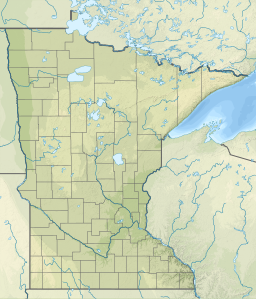
Lake Itasca is a small glacial lake, approximately 1.8 square miles in area. Located in southeastern Clearwater County, in the Headwaters area of north central Minnesota, it is notable for being the headwater of the Mississippi River. The lake is in Itasca State Park. It has an average depth of 20 to 35 feet and is 1,475 feet (450 m) above sea level.

The Schoolcraft River is a tributary of the Mississippi River, approximately 30 mi (48 km) long, in northern Minnesota in the United States. Although short, it is considered as the first major tributary of the Mississippi, since it is the first river that joins the Mississippi below its source that is nearly the same size as the Mississippi itself. The river is named after Henry Schoolcraft, who mapped the region and discovered nearby Lake Itasca as the source of the Mississippi in 1831. Its name in the Ojibwe language is Ozaawindibe-ziibi, named after Ozaawindib who guided Schoolcraft to the nearby Omashkoozo-zaaga'igan, which Schoolcraft then named Lake Itasca. Prior to being named for these early explorers it had been called the "Naiwa River"

Lake Bemidji is a small glacially-formed lake, approximately 11 square miles in area, in northern Minnesota in the United States. Located less than 50 miles (80 km) downstream from the source of the Mississippi River, it both receives and is drained by the Mississippi.

The Rainy River is a river, approximately 137 miles (220 km) long, forming part of the Canada–United States border separating Northwestern Ontario and northern Minnesota.

The Lac Courte Oreilles Tribe is one of six federally recognized bands of Ojibwe people located in present-day Wisconsin. It had 7,275 enrolled members as of 2010. The band is based at the Lac Courte Oreilles Indian Reservation in northwestern Wisconsin, which surrounds Lac Courte Oreilles. The main reservation's land is in west-central Sawyer County, but two small plots of off-reservation trust land are located in Rusk, Burnett, and Washburn counties. The reservation was established in 1854 by the second Treaty of La Pointe.

Red Lake is a lake in Beltrami County in northern Minnesota.
Lake Windigo is a small lake on Star Island in northern Minnesota, United States. The lake covers a total of 199 acres (80 hectare) and reaches a maximum depth of 15 feet (4.6 m). The littoral zone is 129 acres (52 hectare). Due to its shallow depth and subsequent abundant plant and algae growth, water clarity extends 6 feet (1.8 m). The lake hosts small populations of northern pike and walleye and large communities of panfish. Access to Lake Windigo is by a short portage from Cass Lake on the north side of the island. The lake is best navigated by canoe, rowboat, or other small watercraft.

Ozaawindib (Ojibwe) was an early 19th century assigned male at birth ayaakwe/agokwa warrior who had several husbands and was in other ways gender-nonconforming.

Mille Lacs Lake is a large but shallow lake in the U.S. state of Minnesota. It is located in the counties of Mille Lacs, Aitkin, and Crow Wing, roughly 75 miles north of the Minneapolis-St. Paul metropolitan area.

Grindstone Lake is a large freshwater lake located in Dell Grove Township, Pine County, in east-central Minnesota approximately 6.5 miles (10.5 km) west of Sandstone, Minnesota. The lake is roughly oval shaped being approximately 2 miles (3.2 km) in length north to south and 0.5 miles (0.80 km) east to west, and a maximum depth of 153 feet (47 m). The lake has several small streams that drain the area wetlands and is considered the headwater for the Grindstone River. The lake's name is a translation from the Ojibwe zhiigwanaabikokaa-zaaga'igan. Sandstone taken from near the lake was used to make sharpening stones. The lake, North Fork Grindstone River and the lower course of the Grindstone River are depicted on the 1757 Mitchell Map.
Little Coon Lake is a lake in Anoka County, Minnesota, in the United States.
Shell Lake is a lake in Becker County, Minnesota, in the United States.
Lake Mary is a lake in Douglas County, in the U.S. state of Minnesota.
Garden Lake is a lake in Lake County, in the U.S. state of Minnesota.
Lake Stay is a lake in Lincoln County, in the U.S. state of Minnesota.
Lake Washington is a lake located between Dassel and Darwin in Meeker County, in the U.S. state of Minnesota.
Longyear Lake is a lake in St. Louis County, in the U.S. state of Minnesota.
Lily Lake is a lake in Washington County, in the U.S. state of Minnesota.

Kabetogama Lake or Lake Kabetogama is a clear lake in northern St. Louis County, Minnesota. This body of water lies within Voyageurs National Park, and with a surface area of 25,760 acres (104 km2), it is one of the state's 10 largest inland lakes. Kabetogama Lake drains into Namakan Lake to the east, and roughly parallels the near-by Rainy Lake. The Ojibwe name Gaa-biitoogamaag-zaaga'igan translates to “the lake that lies parallel with another lake” or “the lake that doubles with another lake” or "the place where there is one lake after another." French fur trappers similarly referred to Kabetogama as Travere or Travers, meaning “alongside.” A thin peninsula is all that separates the two lakes. The community of Kabetogama, located along the south shores of the Lake serves as the gateway into the park.
Lake Belle Taine is a lake in Hubbard County, Minnesota, in the United States.











